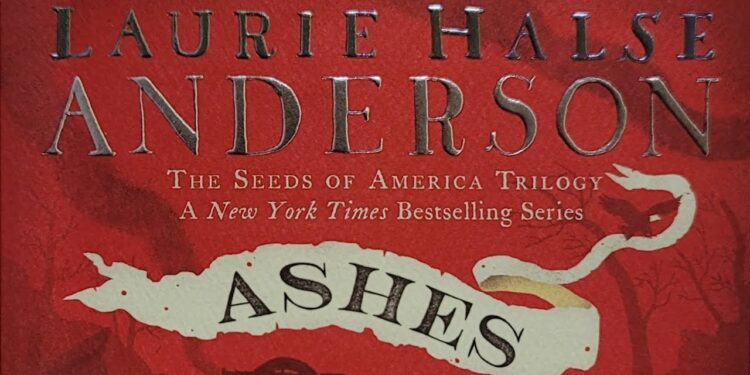Introduction
Ashes Summary And Themes By Laurie Halse Anderson Laurie Halse Anderson’s Ashes is the gripping conclusion to her celebrated Seeds of America trilogy, following the harrowing journey of Isabel and Curzon during the American Revolutionary War. This historical fiction series vividly portrays the struggles of enslaved people seeking freedom in a country fighting for its own independence.
In Ashes, Anderson masterfully intertwines themes of resilience, loyalty, and identity against the backdrop of war and upheaval. The story’s vivid historical context and deeply personal narrative offer readers an unforgettable exploration of what it means to fight for liberty and justice.
Summary
Ashes continues the story of Isabel and Curzon as they journey through a war-torn America in search of Isabel’s younger sister, Ruth, who was taken from her years ago. The narrative picks up with the duo traveling south, with Isabel fiercely determined to reunite with Ruth, even as the Revolutionary War rages around them. Curzon, who has been Isabel’s companion and confidant, shares her struggles but also grapples with his own loyalty to the revolutionary cause. Their bond is tested as their paths and priorities diverge.
Read more
When Isabel finally locates Ruth, the reunion is bittersweet. Ruth, now a young woman, has been living on a plantation under harsh conditions and has mixed feelings about Isabel’s sudden reappearance. Ruth’s transformation highlights the toll of separation and the scars of enslavement, complicating Isabel’s vision of a perfect reunion.
As they navigate this new chapter, the Revolutionary War intensifies, pulling Isabel and Curzon into its chaos. They join the Patriot army and experience the grim realities of war, including hunger, cold, and the ever-present threat of death. Despite the physical and emotional challenges, the war also provides moments of hope and camaraderie, illustrating the human capacity for resilience and solidarity.
The novel’s climax brings the characters to a crossroads where they must confront not only the external battle for freedom but also their internal struggles with trust, forgiveness, and self-worth. In the end, Isabel, Curzon, and Ruth emerge as survivors, each finding their own path to freedom and healing. Anderson’s conclusion is both poignant and hopeful, emphasizing the enduring fight for equality and the unyielding spirit of those who resist oppression.

Themes
- Freedom and Independence
The novel explores freedom on multiple levels—personal, political, and societal. Isabel’s journey to free her sister parallels the colonies’ fight for independence, drawing a poignant connection between individual struggles and collective liberation.
Read more
- Family and Loyalty
The bond between Isabel and Ruth is at the heart of the story, underscoring the sacrifices and challenges involved in reuniting a fractured family. Curzon’s loyalty to Isabel, despite their differences, highlights the complexities of relationships forged under duress. - Resilience and Survival
Isabel’s determination to overcome every obstacle in her path demonstrates the resilience required to survive in a world defined by slavery and war. Her story is a testament to the strength of the human spirit in the face of unimaginable adversity. - Identity and Self-Discovery
Throughout the trilogy, Isabel grapples with questions of identity and self-worth. In Ashes, she begins to reconcile her past and present, finding strength in her sense of self and purpose. - The Cost of War
Anderson does not shy away from depicting the grim realities of the Revolutionary War, showing how it affects soldiers and civilians alike. The narrative emphasizes the human cost of conflict, even in the pursuit of noble ideals. - Justice and Inequality
The novel critiques the hypocrisy of a nation fighting for independence while upholding slavery. Through Isabel’s perspective, Anderson highlights the systemic injustices faced by enslaved people and the long road toward true equality.

Conclusion
Laurie Halse Anderson’s Ashes is a deeply moving and thought-provoking conclusion to the Seeds of America trilogy. Through Isabel’s journey, the novel explores themes of freedom, resilience, and justice, offering a poignant commentary on the contradictions of the American Revolution. Anderson’s rich character development, combined with her commitment to historical accuracy, makes Ashes a standout work in historical fiction. The story’s emotional depth and powerful themes ensure its resonance with readers long after the final page.
Read more
FAQs
Q: What makes Ashes a compelling conclusion to the Seeds of America trilogy?
A: Ashes ties together the personal and historical threads of the series, delivering a satisfying resolution to Isabel and Curzon’s journey. The novel’s nuanced portrayal of character growth and its unflinching depiction of the Revolutionary War make it a powerful and thought-provoking read.
Q: How does the relationship between Isabel and Curzon evolve in Ashes?
A: Their relationship is tested as they face differing priorities and loyalties. However, their bond deepens as they confront their shared struggles, ultimately finding strength and trust in one another.
Q: What role does Ruth play in the story?
A: Ruth represents both a source of hope and a challenge for Isabel. Her reappearance forces Isabel to confront the complexities of their relationship and the long-term effects of their separation.
Q: Is Ashes historically accurate?
A: While the characters and their stories are fictional, Laurie Halse Anderson meticulously researches the historical context, ensuring that the events, settings, and societal dynamics accurately reflect the Revolutionary War era.
Q: What message does the novel convey about freedom?
A: Ashes underscores that freedom is a universal right, but achieving it often requires immense sacrifice and perseverance. The novel also critiques the irony of a nation fighting for its own liberty while denying it to others.
Read more

















